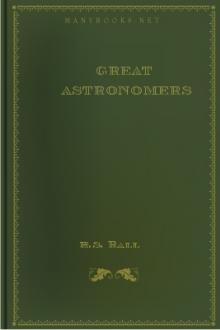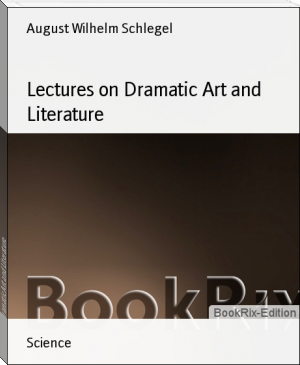Great Astronomers, Robert Stawell Ball [fox in socks read aloud txt] 📗

- Author: Robert Stawell Ball
- Performer: -
Book online «Great Astronomers, Robert Stawell Ball [fox in socks read aloud txt] 📗». Author Robert Stawell Ball
The Project gratefully accepts contributions in money, time,
scanning machines, OCR software, public domain etexts, royalty
free copyright licenses, and every other sort of contribution
you can think of. Money should be paid to “Project Gutenberg
Association / Carnegie-Mellon University”.
We are planning on making some changes in our donation structure
in 2000, so you might want to email me, hart@pobox.com beforehand.
END THE SMALL PRINT! FOR PUBLIC DOMAIN ETEXTSVer.04.29.93*END*
This etext was prepared by
Chris Brennen cbrennen@freenet.co.uk
Jill R. Diffendal
Barb Grow pebareka@iexpress.net.au
Christine L Hall Goleta, CA. USA
Pamela L. Hall pamhall@www.edu
GREAT ASTRONOMERS
By
SIR ROBERT S. BALL D.Sc. LL.D. F.R.S.
Lowndean Professor of Astronomy and Geometry in the
University of Cambridge
Author of “In Starry Realms” ” In the High Heavens” etc.
[PLATE: GREENWICH OBSERVATORY.]
PREFACE.
It has been my object in these pages to present the life of each
astronomer in such detail as to enable the reader to realise in
some degree the man’s character and surroundings; and I have
endeavoured to indicate as clearly as circumstances would permit
the main features of the discoveries by which he has become known.
There are many types of astronomers—from the stargazer who merely
watches the heavens, to the abstract mathematician who merely
works at his desk; it has, consequently, been necessary in the
case of some lives to adopt a very different treatment from that
which seemed suitable for others.
While the work was in progress, some of the sketches appeared in
“Good Words.” The chapter on Brinkley has been chiefly derived from
an article on the “History of Dunsink Observatory,” which was
published on the occasion of the tercentenary celebration of the
University of Dublin in 1892, and the life of Sir William Rowan
Hamilton is taken, with a few alterations and omissions, from an
article contributed to the “Quarterly Review” on Graves’ life of
the great mathematician. The remaining chapters now appear for
the first time. For many of the facts contained in the sketch of
the late Professor Adams, I am indebted to the obituary notice
written by my friend Dr. J.W.L. Glaisher, for the Royal Astronomical
Society; while with regard to the late Sir George Airy, I have a
similar acknowledgment to make to Professor H.H. Turner. To my
friend Dr. Arthur A. Rambaut I owe my hearty thanks for his
kindness in aiding me in the revision of the work.
R.S.B.
The Observatory, Cambridge.
October, 1895
CONTENTS.
INTRODUCTION.
PTOLEMY.
COPERNICUS.
TYCHO BRAHE.
GALILEO.
KEPLER.
ISAAC NEWTON.
FLAMSTEED.
HALLEY.
BRADLEY.
WILLIAM HERSCHEL.
LAPLACE.
BRINKLEY.
JOHN HERSCHEL.
THE EARL OF ROSSE.
AIRY.
HAMILTON.
LE VERRIER.
ADAMS.
LIST OF ILLUSTRATIONS.
THE OBSERVATORY, GREENWICH.
PTOLEMY.
PTOLEMY’S PLANETARY SCHEME.
PTOLEMY’S THEORY OF THE MOVEMENT OF MARS.
THORN, FROM AN OLD PRINT.
COPERNICUS.
FRAUENBURG, FROM AN OLD PRINT.
EXPLANATION OF PLANETARY MOVEMENTS.
TYCHO BRAHE.
TYCHO’S CROSS STAFF.
TYCHO’S “NEW STAR” SEXTANT OF 1572.
TYCHO’S TRIGONIC SEXTANT.
TYCHO’S ASTRONOMIC SEXTANT.
TYCHO’S EQUATORIAL ARMILLARY.
THE GREAT AUGSBURG QUADRANT.
TYCHO’S “NEW SCHEME OF THE TERRESTRIAL SYSTEM,” 1577.
URANIBORG AND ITS GROUNDS.
GROUND-PLAN OF THE OBSERVATORY.
THE OBSERVATORY OF URANIBORG, ISLAND OF HVEN.
EFFIGY ON TYCHO’S TOMB AT PRAGUE.
By Permission of Messrs. A. & C. Black.
TYCHO’S MURAL QUADRANT, URANIBORG.
GALILEO’S PENDULUM.
GALILEO.
THE VILLA ARCETRI.
FACSIMILE SKETCH OF LUNAR SURFACE BY GALILEO.
CREST OF GALILEO’S FAMILY.
KEPLER’S SYSTEM OF REGULAR SOLIDS.
KEPLER.
SYMBOLICAL REPRESENTATION OF THE PLANETARY SYSTEM.
THE COMMEMORATION OF THE RUDOLPHINE TABLES.
WOOLSTHORPE MANOR.
TRINITY COLLEGE, CAMBRIDGE.
DIAGRAM OF A SUNBEAM.
ISAAC NEWTON.
SIR ISAAC NEWTON’S LITTLE REFLECTOR.
SIR ISAAC NEWTON’S SUN-DIAL.
SIR ISAAC NEWTON’S TELESCOPE.
SIR ISAAC NEWTON’S ASTROLABE.
SIR ISAAC NEWTON’S SUN-DIAL IN THE ROYAL SOCIETY.
FLAMSTEED’S HOUSE.
FLAMSTEED.
HALLEY.
GREENWICH OBSERVATORY IN HALLEY’S TIME.
7, NEW KING STREET, BATH.
From a Photograph by John Poole, Bath.
WILLIAM HERSCHEL.
CAROLINE HERSCHEL.
STREET VIEW, HERSCHEL HOUSE, SLOUGH.
From a Photograph by Hill & Saunders, Eton.
GARDEN VIEW, HERSCHEL HOUSE, SLOUGH.
From a Photograph by Hill & Saunders, Eton.
OBSERVATORY, HERSCHEL HOUSE, SLOUGH.
From a Photograph by Hill & Saunders, Eton.
THE 40-FOOT TELESCOPE, HERSCHEL HOUSE, SLOUGH.
From a Photograph by Hill & Saunders, Eton.
LAPLACE.
THE OBSERVATORY, DUNSINK.
From a Photograph by W. Lawrence, Dublin.
ASTRONOMETER MADE BY SIR JOHN HERSCHEL.
SIR JOHN HERSCHEL.
NEBULA IN SOUTHERN HEMISPHERE.
THE CLUSTER IN THE CENTAUR.
OBSERVATORY AT FELDHAUSEN.
GRANITE COLUMN AT FELDHAUSEN.
THE EARL OF ROSSE.
BIRR CASTLE.
From a Photograph by W. Lawrence, Dublin.
THE MALL, PARSONSTOWN.
From a Photograph by W. Lawrence, Dublin.
LORD ROSSE’S TELESCOPE.
From a Photograph by W. Lawrence, Dublin.
ROMAN CATHOLIC CHURCH, PARSONSTOWN.
From a Photograph by W. Lawrence, Dublin.
AIRY.
From a Photograph by E.P. Adams, Greenwich.
HAMILTON.
ADAMS.
THE OBSERVATORY, CAMBRIDGE.
INTRODUCTION.
Of all the natural sciences there is not one which offers such
sublime objects to the attention of the inquirer as does the
science of astronomy. From the earliest ages the study of the
stars has exercised the same fascination as it possesses at the
present day. Among the most primitive peoples, the movements of
the sun, the moon, and the stars commanded attention from their
supposed influence on human affairs.
The practical utilities of astronomy were also obvious in primeval
times. Maxims of extreme antiquity show how the avocations of the
husbandman are to be guided by the movements of the heavenly
bodies. The positions of the stars indicated the time to plough,
and the time to sow. To the mariner who was seeking a way across
the trackless ocean, the heavenly bodies offered the only reliable
marks by which his path could be guided. There was, accordingly,
a stimulus both from intellectual curiosity and from practical
necessity to follow the movements of the stars. Thus began a
search for the causes of the ever-varying phenomena which the
heavens display.
Many of the earliest discoveries are indeed prehistoric. The
great diurnal movement of the heavens, and the annual revolution
of the sun, seem to have been known in times far more ancient than
those to which any human monuments can be referred. The acuteness
of the early observers enabled them to single out the more
important of the wanderers which we now call planets. They saw
that the star-like objects, Jupiter, Saturn, and Mars, with the
more conspicuous Venus, constituted a class of bodies wholly
distinct from the fixed stars among which their movements lay, and
to which they bear such a superficial resemblance. But the
penetration of the early astronomers went even further, for they
recognized that Mercury also belongs to the same group, though
this particular object is seen so rarely. It would seem that
eclipses and other phenomena were observed at Babylon from a very
remote period, while the most ancient records of celestial
observations that we possess are to be found in the Chinese
annals.
The study of astronomy, in the sense in which we understand the
word, may be said to have commenced under the reign of the
Ptolemies at Alexandria. The most famous name in the science of
this period is that of Hipparchus who lived and worked at Rhodes
about the year 160BC. It was his splendid investigations that
first wrought the observed facts into a coherent branch of
knowledge. He recognized the primary obligation which lies on the
student of the heavens to compile as complete an inventory as
possible of the objects which are there to be found. Hipparchus
accordingly commenced by undertaking, on a small scale, a task
exactly similar to that on which modern astronomers, with all
available appliances of meridian circles, and photographic
telescopes, are constantly engaged at the present day. He
compiled a catalogue of the principal fixed stars, which is of
special value to astronomers, as being the earliest work of its
kind which has been handed down. He also studied the movements of
the sun and the moon, and framed theories to account for the
incessant changes which he saw in progress. He found a much more
difficult problem in his attempt to interpret satisfactorily the
complicated movements of the planets. With the view of
constructing a theory which should give some coherent account of
the subject, he made many observations of the places of these
wandering stars. How great were the advances which Hipparchus
accomplished may be appreciated if we reflect that, as a
preliminary task to his more purely astronomical labours, he had
to invent that branch of mathematical science by which alone the
problems he proposed could be solved. It was for this purpose
that he devised the indispensable method of calculation which we
now know so well as trigonometry. Without the aid rendered by
this beautiful art it would have been impossible for any really
important advance in astronomical calculation to have been
effected.
But the discovery which shows, beyond all others, that Hipparchus
possessed one of the master-minds of all time was the detection of
that remarkable celestial movement known as the precession of the
equinoxes. The inquiry which conducted to this discovery involved
a most profound investigation, especially when it is remembered
that in the days of Hipparchus the means of observation of the
heavenly bodies were only of the rudest description, and the
available observations of earlier dates were extremely scanty.
We can but look with astonishment on the genius of the man who, in
spite of such difficulties, was able to detect such a phenomenon
as the precession, and to exhibit its actual magnitude. I shall
endeavour to explain the nature of this singular celestial
movement, for it may be said to offer the first instance in the
history of science in which we find that combination of accurate
observation with skilful interpretation, of which, in the
subsequent development of astronomy, we have so many splendid
examples.
The word equinox implies the condition that the night is equal to
the day. To a resident on the equator the night is no doubt equal
to the day at all times in the year, but to one who lives on any
other part of the earth, in either hemisphere, the night and the
day are not generally equal. There is, however, one occasion in
spring, and another in autumn, on which the day and the night are
each twelve hours at all places on the earth. When the night and
day are equal in spring, the point which the sun occupies on the
heavens is termed the vernal equinox. There is similarly another
point in which the sun is situated at the time of the autumnal
equinox. In any investigation of the celestial movements the
positions of these two equinoxes on the heavens are of primary
importance, and Hipparchus, with the instinct of genius, perceived
their significance, and commenced to study them. It will be
understood that we can always define the position of a point on
the sky with reference to the surrounding stars. No doubt we do
not see the stars near the sun when the sun is shining, but they
are there nevertheless. The ingenuity of Hipparchus enabled him
to determine the positions of each of the two equinoxes relatively
to the stars which lie in its immediate vicinity. After
examination of the celestial places of these points at different
periods, he was led to the conclusion that each equinox was moving
relatively to the stars, though that movement was so slow that
twenty five





Comments (0)